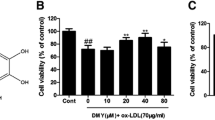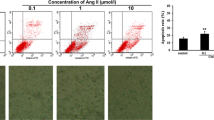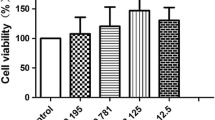Abstract
Vinorelbine tartrate (VNR), a semi-synthetic vinca alkaloid acquired from vinblastine, has extensively been used as an anticancer agent. However, VNR-induced oxidative damage may cause several side effects, such as venous irritation, vascular pain, and necrotizing vasculitis, thereby repressing clinical treatment efficiency. The molecular mechanisms underlying the induced oxidative stress in endothelial cells are still largely unknown. This study was designed to test the hypothesis that VNR induces oxidative injury through modulation of AMP-activated protein kinase (AMPK) and possible mechanisms were then explored. Human umbilical vein endothelial cells (HUVECs) were treated with VNR (5–0.625 μM) to produce oxidative damage. The VNR-mediated AMPK, PKC, and NADPH oxidase expressions were investigated by western blotting. Furthermore, several oxidative stress-induced oxidative damage markers as well as pro-inflammatory responses were also investigated. VNR treatment resulted in dephosphorylation of AMPK, which in turn led to an activation of NADPH oxidase by PKC; however, the phenomena were repressed by AICAR (an agonist of AMPK). Furthermore, VNR suppressed Akt/eNOS and enhanced p38 mitogen-activated protein kinase (MAPK), which in turn activated the NF-κB pathway. Furthermore, VNR facilitated several pro-inflammatory events, such as the adherence of monocytic THP-1 cells to HUVECs, pro-inflammatory cytokines release, and overexpression of adhesion molecular. Our results highlight a possible molecular mechanism for VNR-mediated endothelial dysfunction.








Similar content being viewed by others
Abbreviations
- VNR:
-
Vinorelbine tartrate
- ROS:
-
Reactive oxygen species
- AMPK:
-
AMP-activated protein kinase
- PKC:
-
Protein kinase C
- MAPK:
-
Mitogen-activated protein kinase
- DPI:
-
Diphenyleneiodonium
- EDTA:
-
Ethylene diaminotetraacetic acid
- VCAM-1:
-
Vascular cell adhesion molecule-1
- ICAM-1:
-
Intercellular adhesion molecules
- IL-8:
-
Interleukin-8
- NO:
-
Nitric oxide
- eNOS:
-
Endothelial NO synthase
References
Budman, D. R. (1992). New vinca alkaloids and related compounds. Seminars in Oncology, 19(6), 639–645.
Marty, M., Extra, J. M., Dieras, V., Giacchetti, S., Ohana, S., & Espie, M. (1992). A review of the antitumour activity of vinorelbine in breast cancer. Drugs, 44(Suppl 4), 29–35. Discussion: 66–29.
Sorensen, J. B. (1992). Vinorelbine: A review of its antitumour activity in lung cancer. Drugs, 44(Suppl 4), 60–65. Discussion: 66–69.
Jordan, M. A., & Wilson, L. (2004). Microtubules as a target for anticancer drugs. Nature Reviews Cancer, 4(4), 253–265.
Ngan, V. K., Bellman, K., Hill, B. T., Wilson, L., & Jordan, M. A. (2001). Mechanism of mitotic block and inhibition of cell proliferation by the semisynthetic Vinca alkaloids vinorelbine and its newer derivative vinflunine. Molecular Pharmacology, 60(1), 225–232.
Rittenberg, C. N., Gralla, R. J., & Rehmeyer, T. A. (1995). Assessing and managing venous irritation associated with vinorelbine tartrate (Navelbine). Oncology Nursing Forum, 22(4), 707–710.
Yamada, T., Egashira, N., Imuta, M., Yano, T., Yamauchi, Y., Watanabe, H., et al. (2010). Role of oxidative stress in vinorelbine-induced vascular endothelial cell injury. Free Radical Biology and Medicine, 48(1), 120–127.
Dong, Y., Zhang, M., Wang, S., Liang, B., Zhao, Z., Liu, C., et al. (2010). Activation of AMP-activated protein kinase inhibits oxidized LDL-triggered endoplasmic reticulum stress in vivo. Diabetes, 59(6), 1386–1396.
Hardie, D. G. (2007). AMP-activated/SNF1 protein kinases: Conserved guardians of cellular energy. Nature Reviews Molecular Cell Biology, 8(10), 774–785.
Fisslthaler, B., & Fleming, I. (2009). Activation and signaling by the AMP-activated protein kinase in endothelial cells. Circulation Research, 105(2), 114–127.
Michell, B. J., Chen, Z., Tiganis, T., Stapleton, D., Katsis, F., Power, D. A., et al. (2001). Coordinated control of endothelial nitric-oxide synthase phosphorylation by protein kinase C and the cAMP-dependent protein kinase. Journal of Biological Chemistry, 276(21), 17625–17628.
Sag, D., Carling, D., Stout, R. D., & Suttles, J. (2008). Adenosine 5′-monophosphate-activated protein kinase promotes macrophage polarization to an anti-inflammatory functional phenotype. Journal of Immunology, 181(12), 8633–8641.
Ceolotto, G., Gallo, A., Papparella, I., Franco, L., Murphy, E., Iori, E., et al. (2007). Rosiglitazone reduces glucose-induced oxidative stress mediated by NAD(P)H oxidase via AMPK-dependent mechanism. Arteriosclerosis, Thrombosis, and Vascular Biology, 27(12), 2627–2633.
Griendling, K. K., Sorescu, D., & Ushio-Fukai, M. (2000). NAD(P)H oxidase: Role in cardiovascular biology and disease. Circulation Research, 86(5), 494–501.
Li, J. M., & Shah, A. M. (2004). Endothelial cell superoxide generation: Regulation and relevance for cardiovascular pathophysiology. American Journal of Physiology: Regulatory, Integrative and Comparative Physiology, 287(5), R1014–R1030.
Sugimoto, K., Ishibashi, T., Sawamura, T., Inoue, N., Kamioka, M., Uekita, H., et al. (2009). LOX-1-MT1-MMP axis is crucial for RhoA and Rac1 activation induced by oxidized low-density lipoprotein in endothelial cells. Cardiovascular Research, 84(1), 127–136.
Li, D., & Mehta, J. L. (2009). Intracellular signaling of LOX-1 in endothelial cell apoptosis. Circulation Research, 104(5), 566–568.
Navarra, T., Del Turco, S., Berti, S., & Basta, G. (2010). The lectin-like oxidized low-density lipoprotein receptor-1 and its soluble form: Cardiovascular implications. Journal of Atherosclerosis and Thrombosis, 17(4), 317–331.
Tesfamariam, B., & DeFelice, A. F. (2007). Endothelial injury in the initiation and progression of vascular disorders. Vascular Pharmacology, 46(4), 229–237.
Jaffe, E. A., Nachman, R. L., Minick, C. R., & Becker, C. G. (1973). Culture of human endothelial cells derived from umbilical veins. Identification by morphologic and immunologic criteria. Journal of Clinical Investigation, 52(11), 2745–2756.
Hardie, D. G., & Carling, D. (1997). The AMP-activated protein kinase–fuel gauge of the mammalian cell? European Journal of Biochemistry, 246(2), 259–273.
Bey, E. A., Xu, B., Bhattacharjee, A., Oldfield, C. M., Zhao, X., Li, Q., et al. (2004). Protein kinase C delta is required for p47phox phosphorylation and translocation in activated human monocytes. Journal of Immunology, 173(9), 5730–5738.
Ceolotto, G., Papparella, I., Lenzini, L., Sartori, M., Mazzoni, M., Iori, E., et al. (2006). Insulin generates free radicals in human fibroblasts ex vivo by a protein kinase C-dependent mechanism, which is inhibited by pravastatin. Free Radical Biology and Medicine, 41(3), 473–483.
Chavakis, E., Dernbach, E., Hermann, C., Mondorf, U. F., Zeiher, A. M., & Dimmeler, S. (2001). Oxidized LDL inhibits vascular endothelial growth factor-induced endothelial cell migration by an inhibitory effect on the Akt/endothelial nitric oxide synthase pathway. Circulation, 103(16), 2102–2107.
Amaravadi, R., & Thompson, C. B. (2005). The survival kinases Akt and Pim as potential pharmacological targets. Journal of Clinical Investigation, 115(10), 2618–2624.
Inoue, H., Tanabe, T., & Umesono, K. (2000). Feedback control of cyclooxygenase-2 expression through PPARgamma. Journal of Biological Chemistry, 275(36), 28028–28032.
Ricote, M., Li, A. C., Willson, T. M., Kelly, C. J., & Glass, C. K. (1998). The peroxisome proliferator-activated receptor-gamma is a negative regulator of macrophage activation. Nature, 391(6662), 79–82.
Robbesyn, F., Salvayre, R., & Negre-Salvayre, A. (2004). Dual role of oxidized LDL on the NF-kappaB signaling pathway. Free Radical Research, 38(6), 541–551.
Wang, X. F., Zhang, J. Y., Li, L., Zhao, X. Y., Tao, H. L., & Zhang, L. (2011). Metformin improves cardiac function in rats via activation of AMP-activated protein kinase. Clinical and Experimental Pharmacology and Physiology, 38(2), 94–101.
Mugabo, Y., Mukaneza, Y., & Renier, G. (2011). Palmitate induces C-reactive protein expression in human aortic endothelial cells. Relevance to fatty acid-induced endothelial dysfunction. Metabolism, 60(5), 640–648.
Zou, M. H., Hou, X. Y., Shi, C. M., Nagata, D., Walsh, K., & Cohen, R. A. (2002). Modulation by peroxynitrite of Akt- and AMP-activated kinase-dependent Ser1179 phosphorylation of endothelial nitric oxide synthase. Journal of Biological Chemistry, 277(36), 32552–32557.
Eid, A. A., Ford, B. M., Block, K., Kasinath, B. S., Gorin, Y., Ghosh-Choudhury, G., et al. (2010). AMP-activated protein kinase (AMPK) negatively regulates Nox4-dependent activation of p53 and epithelial cell apoptosis in diabetes. Journal of Biological Chemistry, 285(48), 37503–37512.
Alba, G., El Bekay, R., Alvarez-Maqueda, M., Chacon, P., Vega, A., Monteseirin, J., et al. (2004). Stimulators of AMP-activated protein kinase inhibit the respiratory burst in human neutrophils. FEBS Letters, 573(1–3), 219–225.
Kliewer, S. A., Umesono, K., Noonan, D. J., Heyman, R. A., & Evans, R. M. (1992). Convergence of 9-cis retinoic acid and peroxisome proliferator signalling pathways through heterodimer formation of their receptors. Nature, 358(6389), 771–774.
Hu, E., Kim, J. B., Sarraf, P., & Spiegelman, B. M. (1996). Inhibition of adipogenesis through MAP kinase-mediated phosphorylation of PPAR gamma. Science, 274(5295), 2100–2103.
Moon, L., Jun, M. S., Kim, Y. M., Lee, Y. S., Kim, H. J., Seo, H. G., et al. (2011). 7, 8-didehydrocimigenol from Cimicifugae rhizoma inhibits TNF-alpha-induced VCAM-1 but not ICAM-1expression through upregulation of PPAR-gamma in human endothelial cells. Food and Chemical Toxicology, 49(1), 166–172.
Chiba, Y., Ogita, T., Ando, K., & Fujita, T. (2001). PPARgamma ligands inhibit TNF-alpha-induced LOX-1 expression in cultured endothelial cells. Biochemical and Biophysical Research Communications, 286(3), 541–546.
Chen, X. P., Zhang, T. T., & Du, G. H. (2007). Lectin-like oxidized low-density lipoprotein receptor-1, a new promising target for the therapy of atherosclerosis? Cardiovascular Drug Reviews, 25(2), 146–161.
Baldwin, A. S., Jr. (1996). The NF-kappa B and I kappa B proteins: New discoveries and insights. Annual Review of Immunology, 14, 649–683.
Springer, T. A. (1994). Traffic signals for lymphocyte recirculation and leukocyte emigration: The multistep paradigm. Cell, 76(2), 301–314.
Hattori, Y., Suzuki, K., Hattori, S., & Kasai, K. (2006). Metformin inhibits cytokine-induced nuclear factor kappaB activation via AMP-activated protein kinase activation in vascular endothelial cells. Hypertension, 47(6), 1183–1188.
Gauvin, A., Pinguet, F., Poujol, S., Astre, C., & Bressolle, F. (2000). High-performance liquid chromatographic determination of vinorelbine in human plasma and blood: Application to a pharmacokinetic study. Journal of Chromatography B: Biomedical Sciences and Applications, 748(2), 389–399.
Acknowledgments
This study was supported by grants from the National Science Council, (NSC 98-2320-B-039-020-MY3, NSC 97-3111-B-075-001-MY3, 97-2320-B-075-003-MY3), China Medical University (CMU99-S-13), Taiwan, ROC. This study was supported in part by Taiwan Department of Health Clinical Trial and Research Center of Excellence (DOH100-TD-B-111-004).
Author information
Authors and Affiliations
Corresponding author
Rights and permissions
About this article
Cite this article
Tsai, KL., Chiu, TH., Tsai, MH. et al. Vinorelbine-Induced Oxidative Injury in Human Endothelial Cells Mediated by AMPK/PKC/NADPH/NF-κB Pathways. Cell Biochem Biophys 62, 467–479 (2012). https://doi.org/10.1007/s12013-011-9333-y
Published:
Issue Date:
DOI: https://doi.org/10.1007/s12013-011-9333-y




